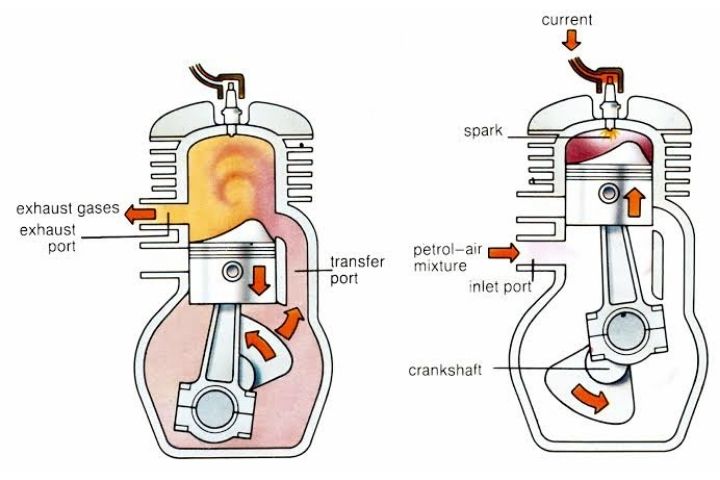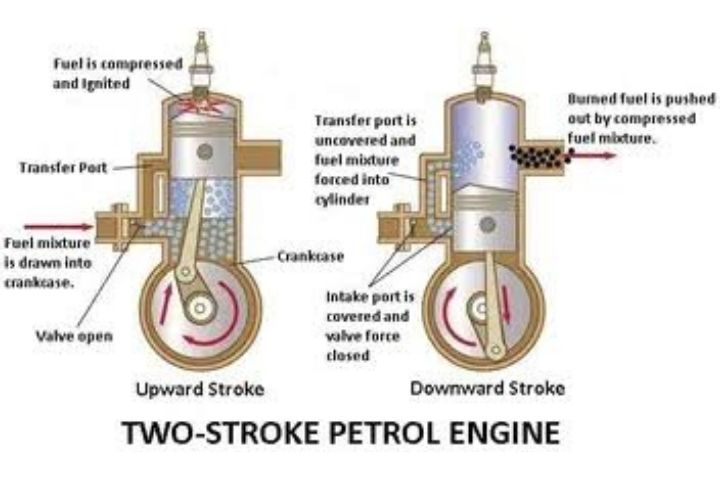Introduction To Two-stroke Engine
Engines are the most fascinating mechanical systems. Different types of engines are available in the market. They are classified based on working, size, construction and a lot more aspects. Differentiating engines on the bassis of working, there are two basic types, two-stroke and four-stroke engine.
In this blog we will tell you about two-stroke engine. Working, constructional feature, advantages, disadvantages and applications of the two-stroke engine will be explained shortly. Let’s get started.
Also Read : Explained : 3 Cylinder Vs 4 Cylinder Engine | Difference, Pros
Working

Internal Combustion engine works on the bassis of power cycle. The power cycle consists of intake, compression, combustion and exhaust. As the name suggest, in a two-stroke engine the power cycle is completed in two-strokes of the piston. In other words, power is generated in one up and one down movement (two-strokes) of the piston.
When the piston moves up for compression, at the same time due to partial vacuum air is drawn into the crankcase. As the piston nears the top, a spark plug ignites the compressed mixture. Thus the chemical energy is then generated to heat energy. This increases the pressure and causes the piston to move down and rotate the crankshaft. As the piston moves down, the burnt out gases exit from the exhaust port.
Therefore, combustion and exhaust takes place at the same time. Notably, the power cycle is completed in one revolution of the crankshaft. In two stroke engine, the exhaust gas in a cylinder is replaced with the fresh air/fuel mixture. This process in know as Scavenging. Different types of Scavenging are employed in IC engines. Crossflow and Uniflow are widely used.

Advantages
- It has few moving parts, therefore it has compact and simple construction.
- With simple mechanism it is also easy to start.
- As we have seen the working, It gives one power stroke per revolution of the crankshaft.
- Due to compact design it is light weight. It is said to be 30% lighter than the 4-stroke engine.
- They are well known for high power to weight ratio and significant power boost.
Also Read : Top 10 Most Powerful Production Cars of The Last Decade
Disadvantages
- Less efficient in terms of fuel economy, thermal and volumetric efficiency.
- Due to incomplete combustion carbon deposits are found on the piston head and exhaust port.
- Therefore they are also high polluting engines with highest hydrocarbon emission rate.
- High wear and tear and shorter life span as compared to four stroke engine.
- High energy output causes vibration and noisy operation.
Application

The two-stroke engines are compartively less expensive to build. They are lighter and can produce a higher power to weight ratio. These can be seen in wide application in the industry. It is used in power tools like leaf blowers, chainsaws, and string trimmers. It was majorly used in motorcycles back then. Manufacturers like Suzuki and Subaru also developed two-stroke engine cars in 1970. Two stroke diesel engines can be seen in ships and electric generation plants.
- Also Read :
- Indian Automobile Industry | 10 Less Known Facts About It
- Top-selling sedans in the US in 2021
- Why Mahindra is popular in India ?
Join Us: Facebook | Whatsapp | Instagram







